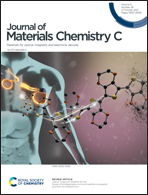Universal vertical standing of block copolymer microdomains enabled by a gradient block†
Abstract
Directed self-assembly of vertically aligned block copolymer (BCP) thin films has been extensively explored as one of the possible bottom-up routes for sub-10 nm patterning technology. To achieve a vertical orientation, it has been imperative to incorporate neutralization layers to balance the interfacial energy difference, which inevitably accompanies processing complexity. Here, a gradient random-copolymer block copolymer system, poly[(styrene-gradient-pentafluorostyrene)-b-methyl methacrylate] [P(S-g-PFS)-b-PMMA] BCP, which realizes universal vertical alignment of sub-10 nm block copolymer lamellae without any top-coat and neutral brush layers, is demonstrated. The surface energy difference between the block junction region and the tail of the gradient random-copolymer block provides a strong energetic preference for vertical lamellae on almost any type of surface, which is well supported by a thermodynamic model. Furthermore, we show that the gradient BCPs can be assembled on EUV lithography patterns to enhance their aspect ratios. This strategy of encoding surface energy balance could be potentially extended to a variety of other self-assembling systems, realizing universal orientation-controllability of nanoscale objects.



 Please wait while we load your content...
Please wait while we load your content...